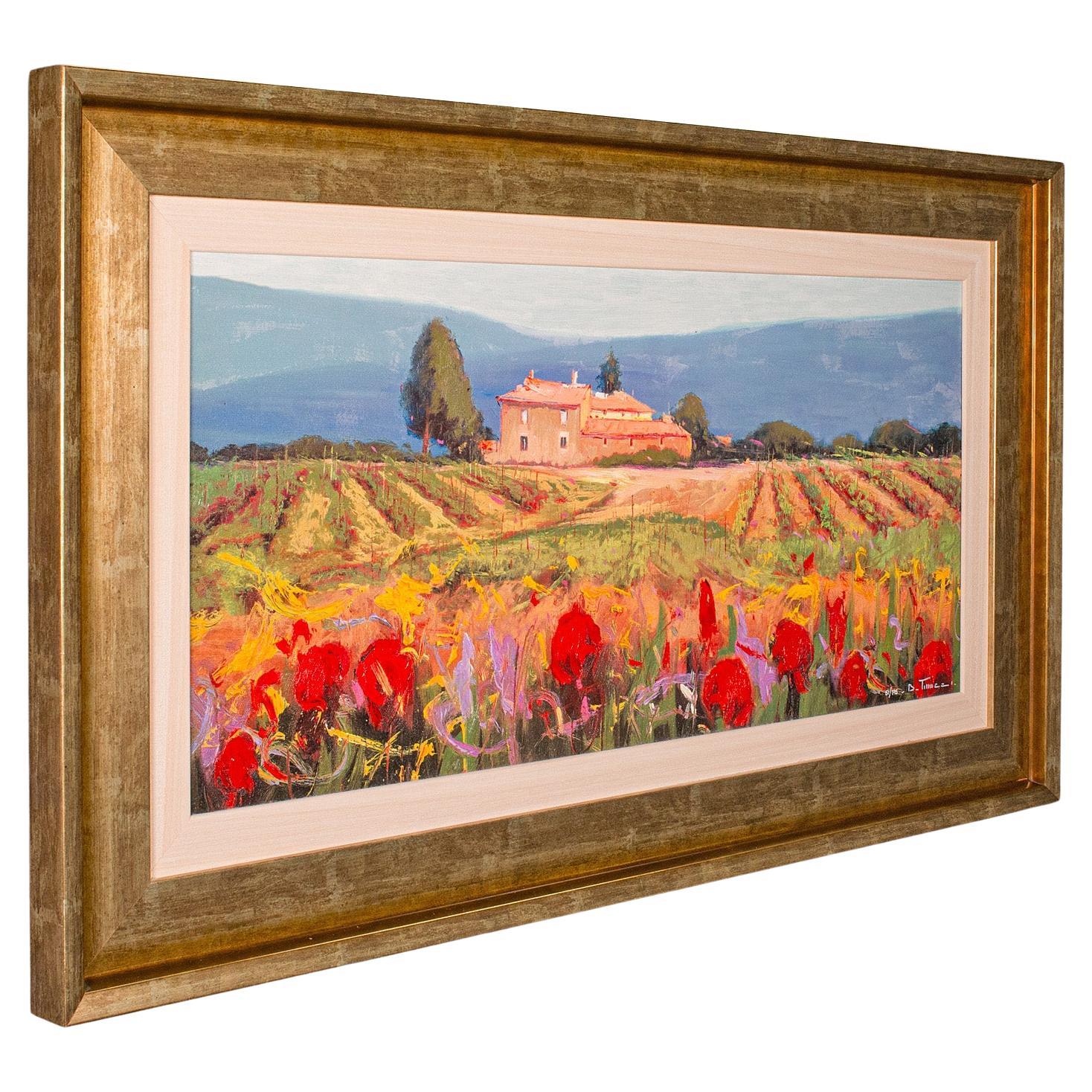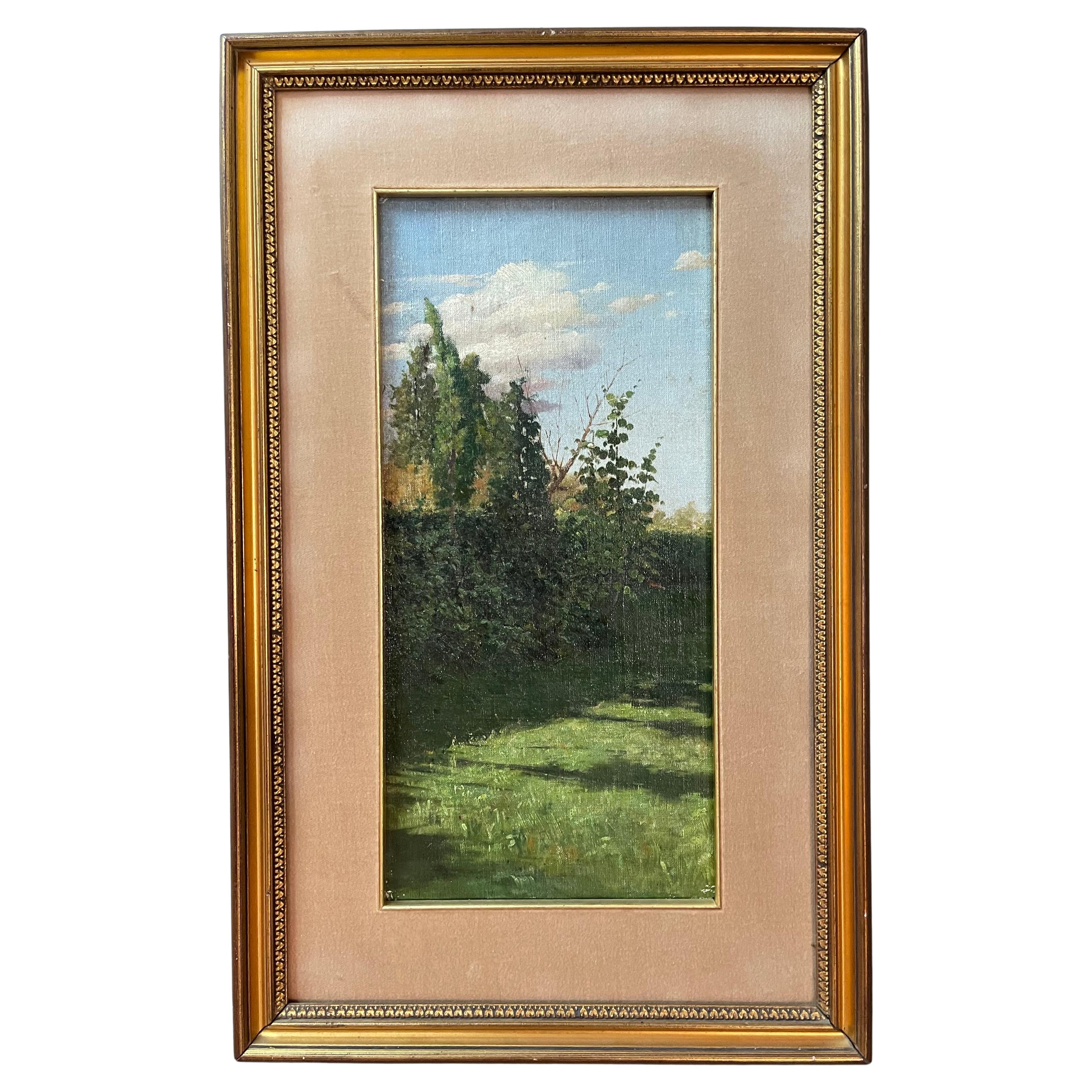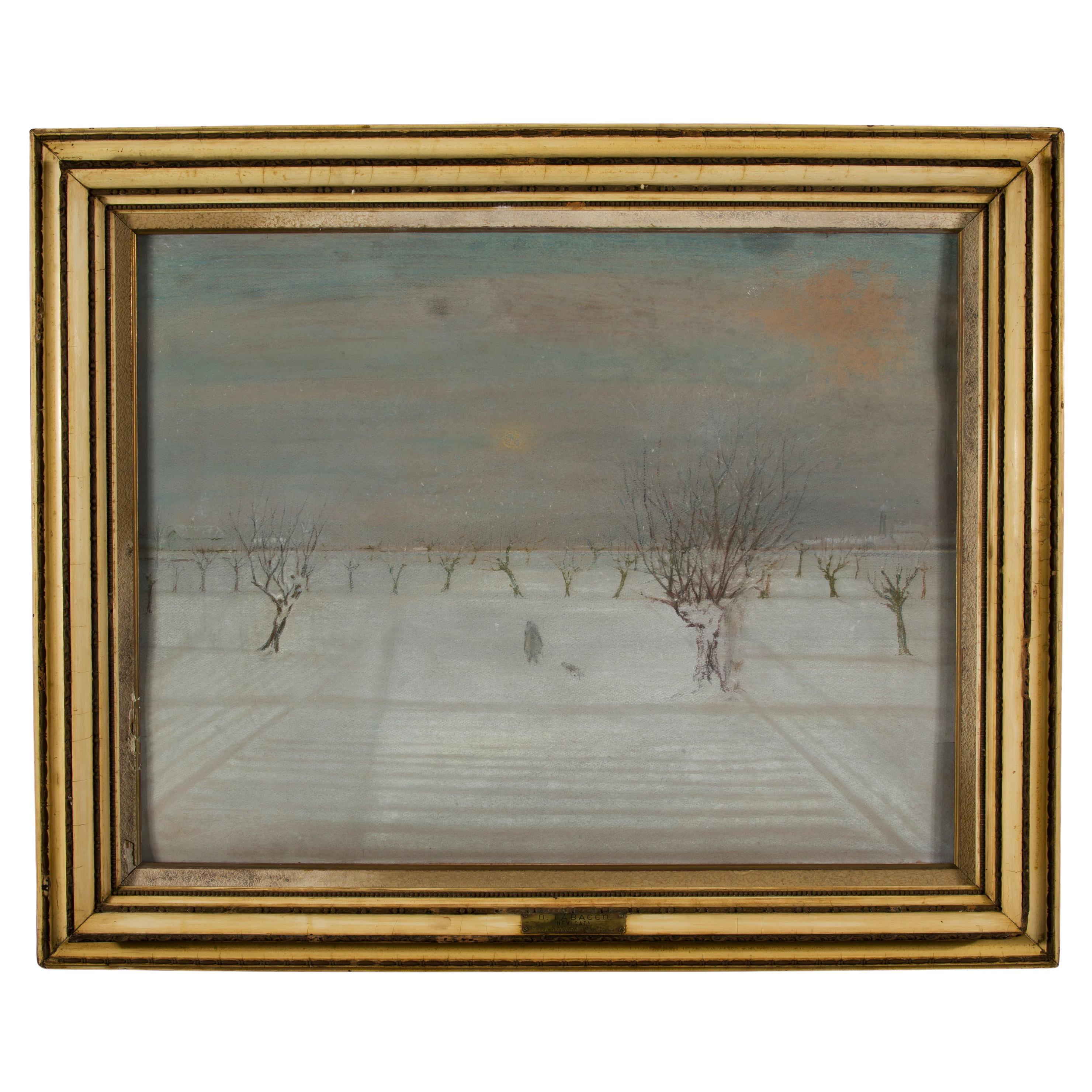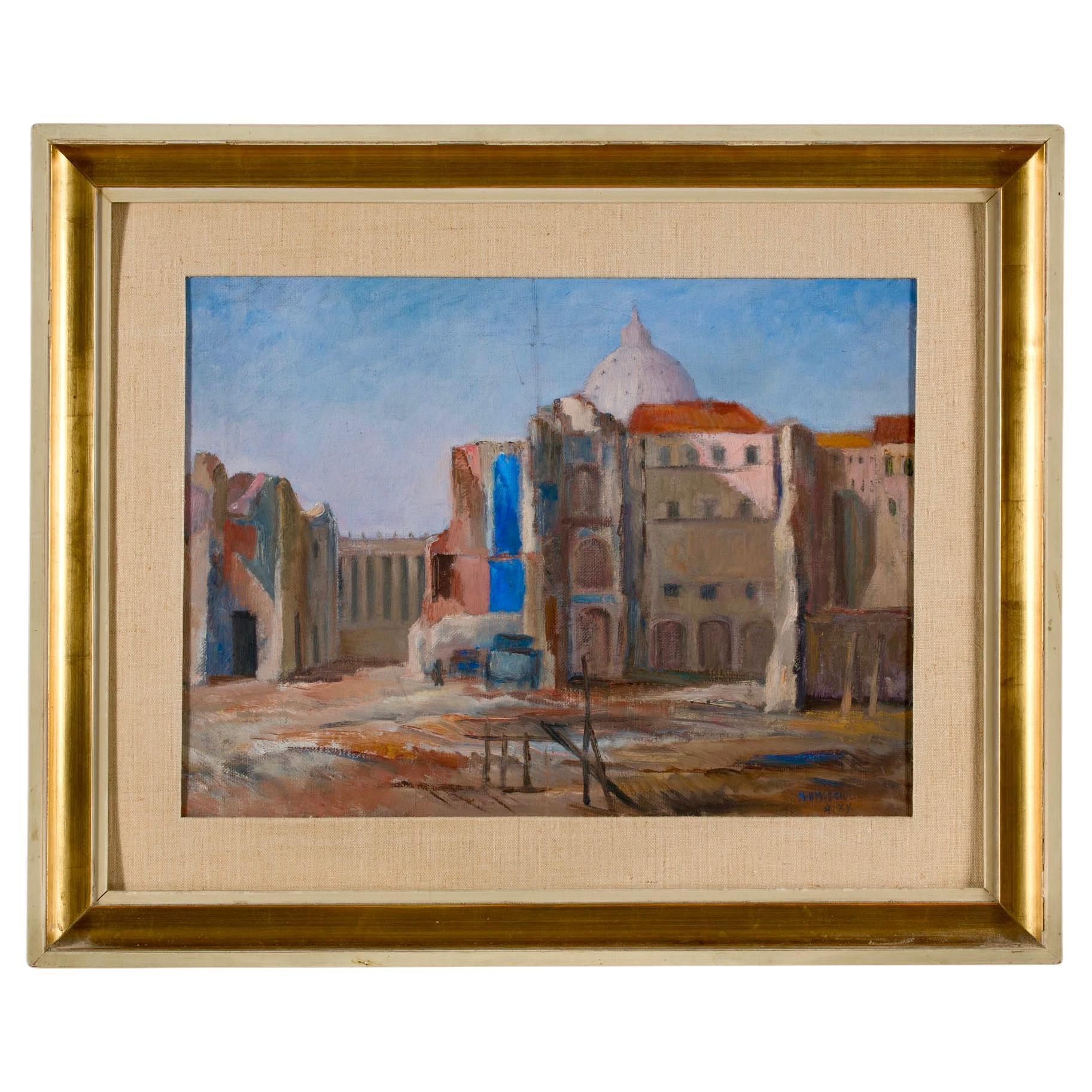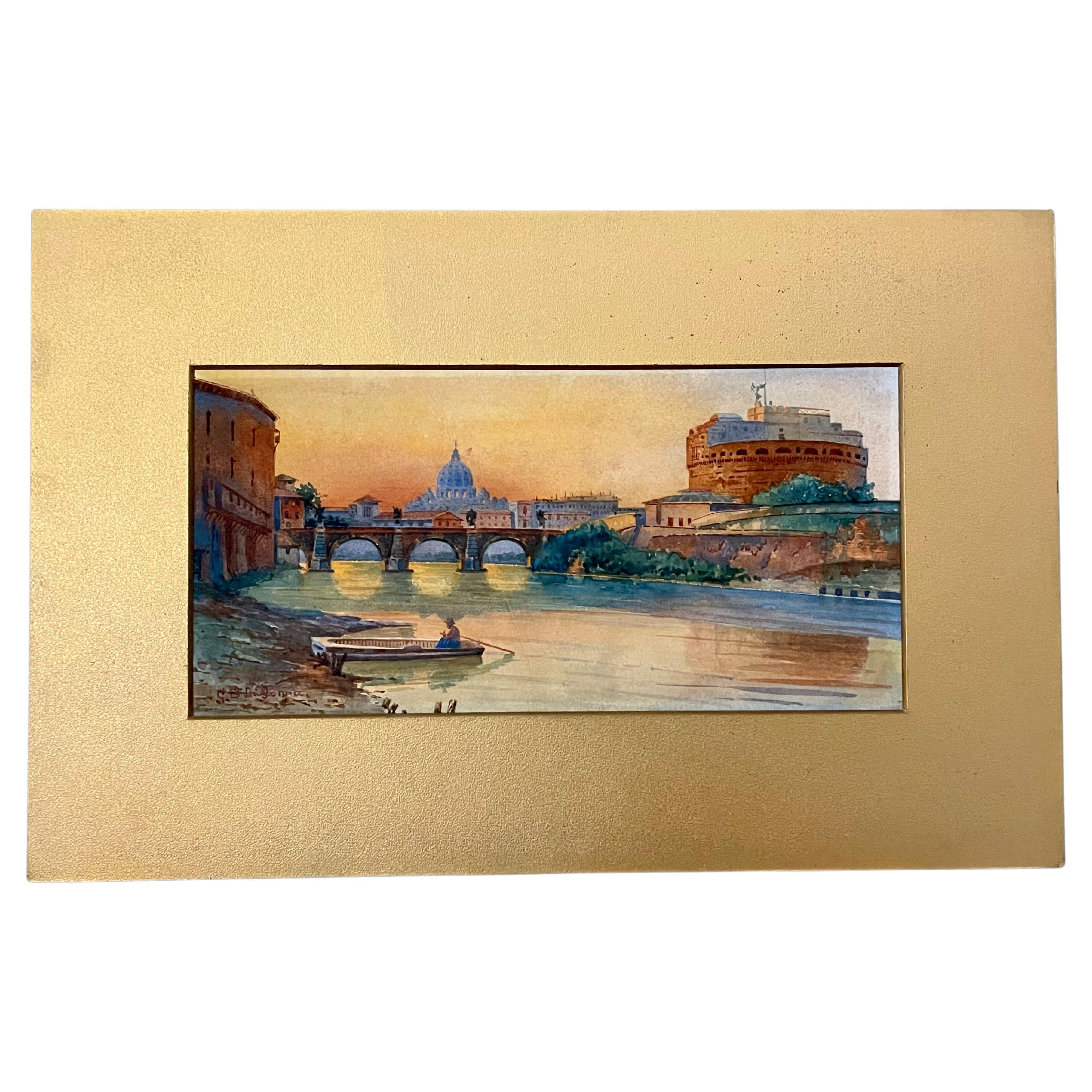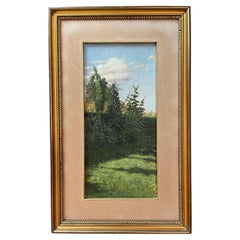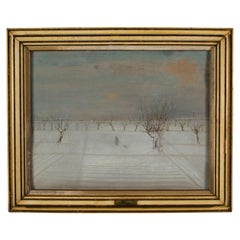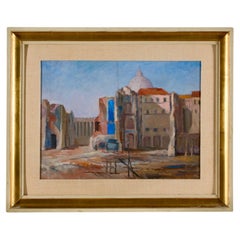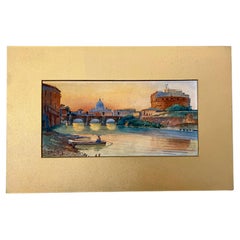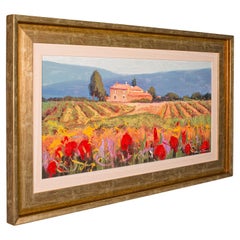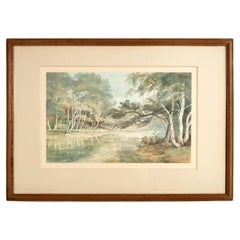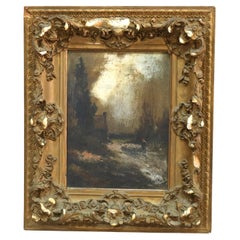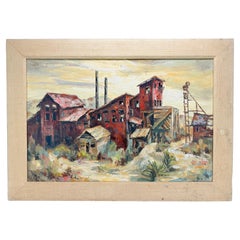Items Similar to Second Futurism Italian Artist Signed Landscape
Want more images or videos?
Request additional images or videos from the seller
1 of 8
Second Futurism Italian Artist Signed Landscape
About the Item
A beautiful and important painting by the great artist Enzo Benedetto, an absolute protagonist of the so-called ‘Second Futurism’.
It depicts a seascape captured in its essence of natural energy with the waves of the sea crashing powerfully on the coast, probably a glimpse of his homeland, Calabria.
This artwork, never before on the market, comes from an important private collection and is beautified by an impressive original frame in wood, in almost perfect condition.
Enzo Benedetto (Reggio Calabria 1905 - Rome 1993)
Benedetto, called Record by Filippo Tommaso Marinetti, approached the Second Futurism in 1924 after meeting Mino Somenzi and was active as a Futurist until his death, becoming a tenacious continuer of the movement's principles, revisited in 1967 with the Futurism Today manifesto. Benedetto theorised and practised the union of colour with the word and coined the term chrome-paroise to define the synthesis of painting and writing.
In 1926 he promoted the futurist hall for the 4th Calabrian Art Biennial in Reggio Calabria where Depero, Dottori, Tato, Fillia, Pozzo, Benedetto Marinetti and himself, amongst others, exhibited.
In 1927 he participated in the National Futurist Exhibition in Palermo.
He moved permanently to Rome in 1927 and joined the Manifesto in 1931.
In a short time he took part in the ‘great Futurist exhibition’ in Imola, the ‘first exhibition of Calabrian art’ in Rome, the ‘33 Futurists’ exhibition at the Pesaro gallery in Milan, and above all the ‘great Futurist exhibition’ at the ‘international artistic circle’ in Via Margutta in Rome.
Benedetto had begun flying in 1926, as a photo of the time documents. That same year, inspired by the exploits of the aviator of the same name, he had executed the painting De Pinedo.
He adhered to the Manifesto already signed by Balla, Marinetti, Depero, Dottori, Tato, Prampolini and Fillia, which advocated the triumph of a spatiality enhanced by flight in its dynamic effects and freed from the fixity of the horizon.
In World War II he was imprisoned in Africa by British troops until the end of the conflict.
Benedetto continued his Futurist activities in the second half of the 20th century.
From 1939 to 1946 he volunteered for the African campaign and was sent to Libya, after which he was imprisoned for six years in the concentration camps in Alexandria, Ismailia, and in India in Bangalore and Yol in Kashmir.
During this imprisonment he was able to paint and some canvases from this period were brought back to Italy, rolled up as personal luggage,
In January 1943, he painted Yol, a new psychological oil portrait of Francesco Tommaso Marinetti.
In 1946, he returned to Italy and in April 1947 presented his first solo exhibition in Rome.
The exhibition dedicated to the great Italian poet and founder of Futurism was opened by Benedetta Marinetti.
He adhered to the Manifesto already signed by Balla, Marinetti, Depero, Dottori, Tato, Prampolini and Fillia, which advocated the triumph of a spatiality enhanced by flight in its dynamic effects and freed from the fixity of the horizon.
In World War II he was imprisoned in Africa by British troops until the end of the conflict.
Benedetto continued his Futurist activities in the second half of the 20th century.
From 1939 to 1946 he volunteered for the African campaign and was sent to Libya, after which he was imprisoned for six years in the concentration camps in Alexandria, Ismailia, and in India in Bangalore and Yol in Kashmir.
During this imprisonment he was able to paint and some canvases from this period were brought back to Italy, rolled up as personal luggage,
In January 1943, he painted Yol, a new psychological oil portrait of Francesco Tommaso Marinetti.
In 1946, he returned to Italy and in April 1947 presented his first solo exhibition in Rome.
The exhibition dedicated to the great Italian poet and founder of Futurism was opened by Benedetta Marinetti.
In 1948 he had a personal exhibition in Capri at the gallery, ‘l'oblò’, and in Reggio Calabria in the Hall of the ‘Francesco Cilea’ Municipal Theatre.
In 1949 he took part in the Calabrian Biennial in Reggio Calabria.
In 1950 quanta took part with ceramics in the Selective Exhibition of Artistic Craftsmanship in the Angelicum in Milan, and with paintings in the Historical Review of Futurism in the Palazzo di Re Enzo in Bologna.
He then held an important solo exhibition in Milan, at the ‘Centro d'Arte San Babila’ and participated in the sixth Quadrennial in Rome. He had a solo exhibition in Fano and another exhibition in Rome in the Galleria del Palazzo delle Esposizioni and in the Galleria del Teatro ‘il Millimetro’.
In 1951 he took part in the collective exhibition ‘Mostra Nazionale della Pittura e della Scultura futurista’ (National Exhibition of Futurist Painting and Sculpture) in Bologna, Palazzo del Podestà, with Acquaviva, Giacomo Balla, Primo Conti, Tullio Crali, Fortunato Depero and Gerardo Dottori.
In 1953 he took part in the exhibition ‘l'arte nella vita del mezzogiorno’ (art in the life of southern Italy) in Rome and was included in the jury for the awarding of prizes. He also took part in the third exhibition ‘il maggio di Bari’ and in the ‘biennale del mare’ in Rimini.
From 1954 to 1960 he took part in many collective exhibitions such as the ‘Sesto Maggio di Bari’, the ‘Villa San Giovanni’ award, the ‘Terni award’, the ‘Avezzano award’, the fifth exhibition of the ‘Triglia d'Oro’, the Michetti award, a personal exhibition in Varese, at the ‘piccola permanente’
In 1961, he stayed in Munich in Germany and exhibited at the Schoeninger Gallery and in the city's ‘Kuntz-Cabnier-Klimt’ studio. Encouraged by his long-standing friendship with Emilio Pettoruti, he also stayed in Paris, where he painted syntheses of the city that were very successful.
In 1962, he held a personal exhibition in Venice at the San Vidal gallery and another in Munich at the Wolfgang Gurlit gallery.
In 1964 he returned to Rome with a solo exhibition at the Antea gallery.
In 1965 he presented his works at the ‘Italian medal exhibition’ at the Paris Mint.
In 1966 he took part in the exhibition of Italian, French and Spanish medals in Rome in the museum of Palazzo Braschi
In 1967, he opened an important personal exhibition in Milan at the ‘venice’ gallery; finally, in June, he promoted the declaration of ‘futurism today’ signed by the painters Giovanni Acquaviva, Alessandro Bruschetti, Angelo Caviglioni, Tullio Cratili, Tullio Dalla Brisola, M.G. Dalmonte, Mino delle Siste, Gerardo Antonio Marasco, Emilio Pettoruti and the architect Alberto Sartoris.
In 1969 he founded the periodical ‘Futurism Today’ published in Rome and organised the first group exhibition sponsored by this newspaper in the hall of the Formia municipal library.
In 1970 he organised the second exhibition of Futurism Today in Prato in the Palazzo Pretorio, entitled ‘15 Futurists’.
In 1972 he organised the third exhibition of Futurism Today. (16 futurists) at the International Centre of Genoa.
In 1974 he had a solo exhibition in Lausanne at the White Gallery. He organised the fifth exhibition of the 25 Futurists in the civic gallery of Faenza and in the Vaggeri workshop in Viareggio.
In 1975, he published Futurism 100%, he was the promoter of the International Committee of Honours to F.T.Marinetti, called by the periodical ‘Futurism Today’ for the first centenary of the poet's birth. More than 100 futurists from all over the world took part.
In 1978 he took part in the IBLA exhibition in Modica, Ragusa and published the 1978 Futurist Almanac with the collaboration of over 100 Futurists.
In 1979, he paid homage to Einstein with an exhibition in Rome at the P21 gallery, while in Reggio Calabria, the municipal administration hosted him with an extensive anthological exhibition as part of the Reggio Calabria cultural autumn.
In 1980 he had a personal exhibition, ‘struttura, ’ in Paris at the N.R.A. gallery, in Milan he took part in the city's biennial and in La Spezia he had a large personal exhibition.
In 1981 he had a solo exhibition at the ‘Maison de la culture’ in Amiens.
In 1983 he took part in an exhibition in the Museum of Modern Art in Paris.
In 1986 he took part in an event in Cosenza in honour of the Calabrian futurist painters Boccioni, Marasco and Benedetto. In Rome, in the cultural space, ‘idea square’, an evening was dedicated to him with the projection of an anthology of paintings, commented by Luigi Tallarico, Giuseppe Selvaggi and Gino Blois.
In Turin, an anthological exhibition at the art gallery ‘il Narciso’ was presented by Marizio Pinottini. at the ‘il luogo’ gallery in Rome, a dedication was made to Benedetto's ‘multiform spaces’ (ceramics, advertising, stage sets, theatre) presented by Mario Verdone.
In 1988, he spoke at the University of Architecture in Reggio Calabria to commemorate Futurism.
In 1989, he held an exhibition of recent works (temperas, set designs, drawings and documents) at Vismararte in Milan, again in defence of the ideological continuity of Futurism. He published the issue of Futurismo Oggi ‘ sodalizio con Marinetti ’ with numerous interventions for the celebration of the 80th birthday of Marinetti's first manifesto.
Since 1990, he has continued his work as an artist and promoter of the ideals of Futurism.
Every item of our Gallery, upon request, is accompanied by a certificate of authenticity issued by Sabrina Egidi official Expert in Italian furniture for the Chamber of Commerce of Rome and for the Rome Civil Courts.
This artwork is shipped from Rome. Under existing legislation, any artwork in Italy created over 70 years ago by an artist who has died can requires a license for export regardless of the work’s market price. The shipping may require additional handling days to require the license according to the destination of the artwork.
- Creator:Enzo Benedetto (Artist)
- Dimensions:Height: 28.35 in (72 cm)Width: 33.47 in (85 cm)Depth: 3.15 in (8 cm)
- Style:Mid-Century Modern (Of the Period)
- Materials and Techniques:
- Place of Origin:
- Period:
- Date of Manufacture:1965 ca.
- Condition:Wear consistent with age and use. Minor fading.
- Seller Location:Roma, IT
- Reference Number:1stDibs: LU4827243071472
About the Seller
5.0
Platinum Seller
Premium sellers with a 4.7+ rating and 24-hour response times
Established in 2005
1stDibs seller since 2019
90 sales on 1stDibs
Typical response time: 3 hours
- ShippingRetrieving quote...Shipping from: Rome, Italy
- Return Policy
Authenticity Guarantee
In the unlikely event there’s an issue with an item’s authenticity, contact us within 1 year for a full refund. DetailsMoney-Back Guarantee
If your item is not as described, is damaged in transit, or does not arrive, contact us within 7 days for a full refund. Details24-Hour Cancellation
You have a 24-hour grace period in which to reconsider your purchase, with no questions asked.Vetted Professional Sellers
Our world-class sellers must adhere to strict standards for service and quality, maintaining the integrity of our listings.Price-Match Guarantee
If you find that a seller listed the same item for a lower price elsewhere, we’ll match it.Trusted Global Delivery
Our best-in-class carrier network provides specialized shipping options worldwide, including custom delivery.More From This Seller
View AllPeriod Italian Signed Landscape
By Ugo Gheduzzi
Located in Roma, IT
1910s Italian Signed Landscape
Beautiful and important oil painting on cardboard by the great Bolognese artist Ugo Gheduzzi (Crespellano BO 5 March 1...
Category
Early 20th Century Italian Belle Époque Paintings
Materials
Wood
Period Italian Signed Landscape Painting
By Demetrio Tabacco
Located in Roma, IT
The great art historian Federico Zeri said that painting snow-covered landscapes was one of the most complicated things for an artist.
Well, in this landscape of the Piedmont country...
Category
Mid-20th Century Italian Mid-Century Modern Paintings
Materials
Canvas, Wood
1930s Italian Signed and Archived Roman Landscape
By Giovanni Omiccioli
Located in Roma, IT
An important and rare painting by the great Italian avant-garde artist Giovanni Omiccioli.
It depicts the so-called Spina di Borgo, the district in front of St. Peter's Basilica dest...
Category
Early 20th Century Italian Mid-Century Modern Paintings
Materials
Wood
Italian Grand Tour Style Signed Landscape
Located in Roma, IT
Important watercolor painting representing a beautiful view of Rome with the Tiber, Castel Sant'Angelo and the dome of St. Peter's in the background.
A typical work in the vein of th...
Category
Antique Late 19th Century Italian Grand Tour Paintings
Materials
Wood, Paper
1860s Italian Signed Neapolitan Landscape Painting
Located in Roma, IT
Beautiful, important painting of the Neapolitan school signed, dated and located. It has a metal plate on the front with the inscription ‘PAESAGGIO NAPOLETANO NUCCI Agosto 1893’.
I...
Category
Antique 1860s Italian Grand Tour Paintings
Materials
Canvas, Wood
Signed Italian Period Painting Neapolitan Landscape
By G. Gianni
Located in Roma, IT
Beautiful and exciting tempera painting by the great artist of the Posillipo School Girolamo Gianni.
It depicts a striking view of the Gulf of Naples with Vesuvius and Castel Sant'El...
Category
Antique Late 19th Century Italian Grand Tour Paintings
Materials
Wood, Paper
You May Also Like
Large Vintage Tuscan Landscape, Italian, Framed Oil on Canvas, Artist Signed
Located in Hele, Devon, GB
This is a large vintage Tuscan landscape. An Italian, framed oil on canvas, dating to the late 20th century, circa 1990.
Self taught, and known as 'the artistic voice of Tuscany', B...
Category
Late 20th Century Italian Mid-Century Modern Paintings
Materials
Canvas, Giltwood
'Wooded Landscape' Watercolour by English Artist Signed Eileen Young
Located in London, GB
'Wooded Landscape' Watercolour by English Artist Eileen Young (1896-1986).
Signed in initials 'EY' bottom right..
The painting depicts a wooded lake scene. Watercolour on paper,...
Category
20th Century English Paintings
Materials
Paint
Antique Oil On Canvas Landscape Painting, Artist Signed, C1890
Located in Big Flats, NY
Antique Oil On Canvas Landscape Painting Signed C1890.
Measures - 18 7/8" x 15 7/8" x 16".
Category
Antique Late 19th Century Paintings
Materials
Canvas
$360 Sale Price
20% Off
WPA Style Industrial Landscape Oil on Board, Signed By Artist
Located in Atlanta, GA
Industrial Landscape in WPA Style by Isaacson, Mid-20th Century. Oil on Board, Measures: 35.5" w x 25.625" h.
This WPA style landscape signed Isaacson, is a striking example of the...
Category
Mid-20th Century American Industrial Paintings
Materials
Paint
California Artist Landscape Painting
Located in Tampa, FL
This beautiful American landscape painting captures the natural beauty and rich tones in a California landscape. Framed in a wood grain finish frame with a linen liner and gold fille...
Category
Vintage 1980s American Paintings
Materials
Canvas, Wood, Paint
French Landscape Oil on Canvas. Signed by Artist. A. Mazar. Circa 1840
Located in Charleston, SC
French landscape oil on canvas in gilt frame. Signed by artist. A. Mazar. Mid 19th Century
Category
